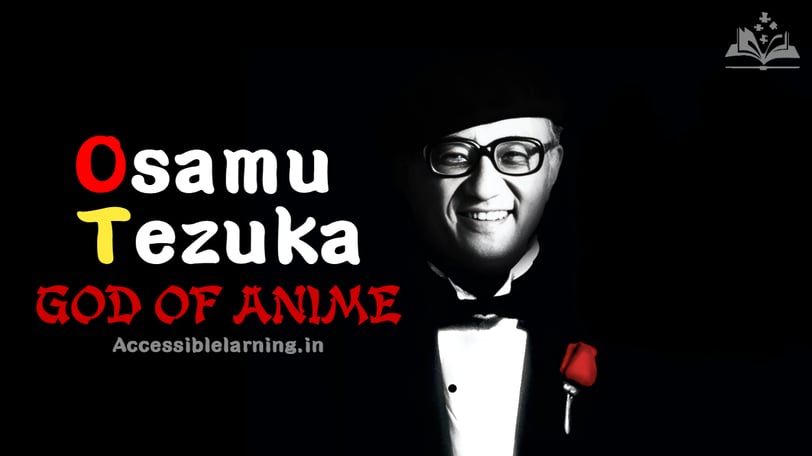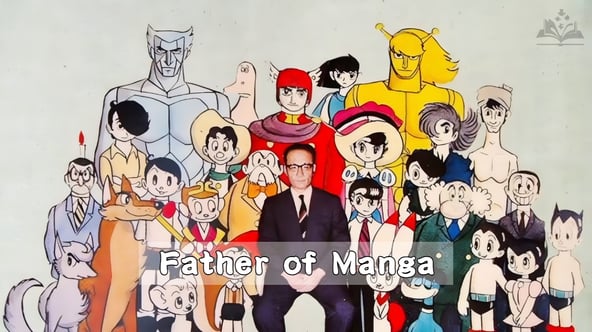
Osamu Tezuka: The Father of Manga and God of Anime!
Explore the world of Osamu Tezuka, the 'Father of Manga', through his iconic works such as Astro Boy, Black Jack and Phoenix. Discover his revolutionary storytelling skills that shaped modern manga and anime.
ANIME INDUSTRYWRITER/POETBIOGRAPHYCOMPANY/INDUSTRYSTORY/ENTERTAINMENT
Sachin K Chaurasiya
9/28/20247 min read


Osamu Tezuka (手塚治虫) (1928-1989) is often regarded as the "Father of Manga/マンガの父" and the "God of Anime/アニメの神様." His immense contributions to Japanese pop culture and global entertainment cannot be underestimated. With his revolutionary approach to storytelling and artistic innovation, Tezuka laid the foundation for the modern manga and anime industries.
Early Life and Inspirations
Born on November 3, 1928, in Toyonaka, Osaka Prefecture, Tezuka developed a deep love for animation and comics at an early age. As a child, he was fascinated by Western animated films, particularly the works of Walt Disney, which greatly influenced his art style. Films such as "Bambi" and "Snow White" left a lasting impression on him and inspired him to combine Japanese visual storytelling with the dynamic motion and expression of Western animation.
During World War II, Tezuka began to explore his creative potential by creating his own manga. After the war, he earned a degree in medicine but soon realized that his passion for comics was greater than his interest in practicing medicine. Nevertheless, his background in medicine would later be reflected in some of his most famous works, such as "Black Jack /ブラックジャック ," which centers around a brilliant but unlicensed surgeon.
Tezuka’s Impact on Manga
Tezuka’s breakthrough came with the 1947 publication of "New Treasure Island (新宝島)" (Shin Takarajima), a manga that captivated readers with its cinematic paneling and gripping narrative. This work is often credited with launching the modern manga industry, setting a standard for storytelling in Japanese comics.
Tezuka’s works were revolutionary because he brought depth and sophistication to manga, treating the medium as more than just a form of entertainment for children. He drew heavily from film techniques, using close-ups, varying camera angles, and sequential pacing to create emotional impact. His style, often referred to as the "cinematic style (映画風), "allowed readers to feel as though they were watching a movie unfold on the page.
One of Tezuka’s most famous creations, "Astro Boy (鉄腕アトム)" (Tetsuwan Atom), was serialized in 1952 and later became one of the most iconic figures in Japanese pop culture. Astro Boy is a robot child with human emotions who fights for justice. The themes of science, ethics, and humanism reflected in Astro Boy mirrored Japan’s fascination with technology in the post-war era and showcased Tezuka’s ability to blend complex ideas with accessible storytelling.


Key Works and Themes
Tezuka's themes often revolved around humanism, morality, and the consequences of scientific progress. He believed in the dignity of all living beings and explored how humans could live in harmony with technology. His works often posed subtle questions about life, death, and morality, especially in relation to medicine and technology, demonstrating his deep philosophical thinking.
Throughout his career, Tezuka created more than 700 manga series and over 150,000 pages of artwork, making him one of the most successful manga artists in history. Some of his most important works include:
"Astro Boy" (Tetsuwan Atom): The story of a robot boy with human emotions who fights for peace, justice, and the betterment of society.
"Kimba the White Lion" (Jungle Taitei): A groundbreaking story about a lion cub who seeks to bring harmony between animals and humans, often seen as a precursor to Disney's The Lion King.
"Black Jack": A medical drama that follows the adventures of a rogue doctor who performs miraculous surgeries. This series reflects Tezuka’s medical background and explores themes of morality, the sanctity of life, and the ethics of medical science.
"Phoenix" (Hi no Tori): An epic saga that spanned centuries and tackled the mysteries of life, death, and rebirth. This is considered one of Tezuka’s most philosophical works, reflecting his own deep questions about humanity and existence.
Tezuka’s Role in Anime
Tezuka's contributions to anime are equally impressive. He founded Mushi Production in 1961, one of the first studios dedicated to creating animated TV series. The studio produced "Astro Boy," which aired in 1963 and became the first domestically produced animated television series in Japan. Its success helped popularize anime in Japan and abroad.
Tezuka's anime was known for being economical with its animation technique. His studio used limited animation, a cost-saving method in which only certain parts of a character moved while others remained still. It was a practical solution to budget constraints, but it later became a defining characteristic of Japanese animation.
Mushi Production also produced "Kimba the White Lion" and "Princess Knight" (Ribbon no Kishi), both of which were pioneers in exploring new genres—adventure and fantasy, respectively—and early shojo (girls' manga).
Lasting Legacy
Osamu Tezuka's influence extends far beyond his lifetime. His artistic innovations, particularly his focus on human emotions, fluid paneling, and storytelling, transformed manga from simple entertainment to a form of literature and art. His deep exploration of morality, the human condition, and the intersection of science and society continue to resonate with audiences today.
Many of the conventions established by Tezuka are now standard in both manga and anime. His works paved the way for countless artists and storytellers in Japan and around the world, cementing his place as a giant in the history of comics and animation.
Even decades after his death in 1989, Tezuka remains an iconic figure. The Osamu Tezuka Cultural Prize, established in 1997, continues to honor manga artists whose works reflect his innovative spirit. Additionally, Tezuka Productions manages his intellectual property, ensuring that his creations remain a part of contemporary pop culture.

List of Notable Manga by Osamu Tezuka
Astro Boy (Tetsuwan Atom) – 1952
Black Jack, 1973
Kimba the White Lion (Jungle Taitei) 1950
Phoenix (Hi no Tori) – 1967
Princess Knight (Ribon no Kishi) 1953
Buddha, 1972
Dororo, 1967
Message to Adolf (Adolf ni Tsugu) – 1983
The Amazing Three (Wonder 3) – 1965
The Three-Eyed One (Mitsume ga Tōru) – 1974
MW – 1976
Ayako, 1972
The Crater, 1969
Ode to Kirihito, 1970
Barbara, 1973
Marvelous Melmo (Fushigi na Melmo) – 1970
Vampire, 1966
Metropolis, 1949
Twin Knights (Futago no Kishi) – 1958
Nextworld (Next World) – 1951
Contextualize Tezuka’s Impact on Pop Culture!
Osamu Tezuka's influence on pop culture extends far beyond the borders of Japan. His innovative storytelling techniques and character designs set a standard that many creators of manga and anime still follow today. Tezuka transformed manga from a simple children's medium into a complex and multifaceted art form, paving the way for genres that cater to all age groups and demographics.
His works, especially "Astro Boy," have become cultural icons that have inspired numerous adaptations into film, television, and even stage performances. The character of Astro Boy has not only become synonymous with Japanese animation but has also influenced global perceptions of anime. Tezuka's stories often included themes of humanity, technology, and morality, prompting readers to reflect on their own lives and societies.
In addition, his influence is evident in the development of the anime industry. Tezuka's founding of Mushi Production in 1961 marked the beginning of serious animation studios in Japan, establishing a structured anime industry that has produced countless successful series and films. Creators such as Hayao Miyazaki and Satoshi Kon have acknowledged Tezuka's influence on their work and have ensured that his legacy continues through new generations of artists and storytellers.
Discuss the Evolution of His Art Style!
Osamu Tezuka's art style evolved significantly over the course of his career, reflecting both personal growth and broader trends in the world of manga and animation. His early work was heavily influenced by Western animation, particularly the fluid, exaggerated look seen in Disney films. This can be seen in his character designs, which often feature large eyes—a stylistic choice that became a hallmark of anime and manga, aimed at expressing a wide range of emotions.
As Tezuka matured as an artist, he began to develop a more distinctive style, emphasizing narrative flow and depth of character. His use of cinematic techniques, such as dynamic panel layouts, varied angles, and dramatic motion, made the storytelling experience more enjoyable. This shift not only revolutionized the way stories were told in manga but also made the medium more appealing to a wider audience.
In works such as "Black Jack," the art took a more detailed and realistic approach, particularly in the depiction of medical scenarios and human emotions. His later works, such as "Phoenix," display a mix of intricate linework and bold illustrations that express the philosophical themes he wanted to explore. This evolution reflects Tezuka's adaptability as an artist, always pushing the boundaries of manga and anime.
Add Quotes and Anecdotes
Quotes
"I want to create a story that touches people's hearts and makes them think about their own lives." This quote reflects Tezuka's desire to incorporate meaningful themes and social commentary into his stories.
"I'm not just a manga artist; I'm a storyteller." This reflects his view of manga as a serious art form that can express complex narratives and emotions.
Anecdotes
Tezuka was known for his exceptional work ethic. It is said that he would often draw late into the night, driven by a combination of passion and a relentless drive to create. At one point, he worked on multiple series simultaneously, which shows his commitment to storytelling.
Despite his fame, Tezuka maintained a humble demeanor. He was often seen as a mentor to young artists, sharing his knowledge and techniques with aspiring creators. This spirit of collaboration and generosity fostered a community of talent that further enriched the manga industry.
An interesting anecdote revolves around Tezuka's early experiences with censorship. In the 1950s, he faced the challenges of content restrictions when publishing "Astro Boy." His clever storytelling and ability to navigate these obstacles not only helped him maintain the integrity of his work, but also demonstrated his innovative approach to tackling complex issues in a family-friendly way.


Osamu Tezuka's 手塚治虫の legacy as the "Father of Manga マンガの父" and "God of Anime アニメの神" is based on his relentless innovation, deep storytelling, and unmatched artistic ability. His works continue to inspire generations of creators and entertain millions of fans worldwide. Through his profound explorations of humanity, morality, and technology, Tezuka not only shaped the world of manga and anime but also left a lasting impact on global culture.
Subscribe to our newsletter
All © Copyright reserved by Accessible-Learning
| Terms & Conditions
Knowledge is power. Learn with Us. 📚


